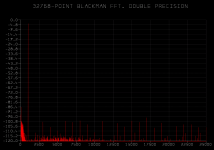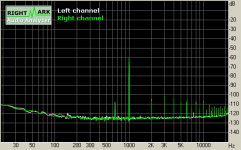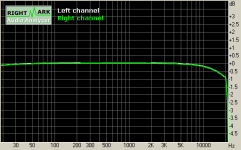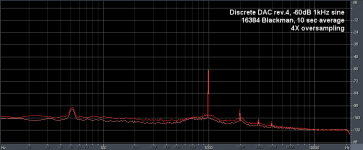Erik,
My first feeling was that a TDA1540-based player player had the most to gain, rather than TDA1541. I don't know how representative Bernhard's own TDA1540 results are, but it looks like the Discrete distorts considerably less, and also has a much lower noise floor.
I've attached the full-size -3dB sine FFT of the right channel from the Rev.2 Discrete, measured using the LynxTWO. The Rev.4 has higher harmonics, but sounds slightly less harsh, so the distortion causing it must be non-harmonic, IMO... there is much more than you'd see from a modern delta-sigma (in basic tests, at least), but it is quite low-level...
(Regarding the cluster of what looks like noise below 1K, this is mostly mains harmonics - I did try "better" PSUs with more PSRR, but it didn't improve what I heard - in one case, quite the opposite).
In the UK, there's a Philips CD-200 on Ebay which has started at a relatively low price. From a search on the forum, it seems this unit does not have a ground plane... but then again, neither did Rev.1-3 of the Discrete. Could be a bit of an RFI problem...
Not sure about the SAA7030 as a filter... it's probably too much to expect someone here to have the actual coefficient set for simulation... from the datasheet, it seems pretty bizarre... 12-bit coefficients?
To me, that immediately suggests poor maximum stopband attenuation (40dB?)... and good attenuation is important to keep IMD to "reasonable" levels. Attenuating hugely directly after the original signal is not necessary, but it needs to make considerable inroads into the first mirror image, IME.
It's a tricky compromise, as it makes life much easier to have a player with unsigned data ouput and separate lines, but if the filter is going to compromise performance, then it won't matter much what DAC goes in there... short of putting in another filter entirely.
It would be rather unfair for me to write off the SAA7030 without having some hands-on experience, though...
- Tom.
My first feeling was that a TDA1540-based player player had the most to gain, rather than TDA1541. I don't know how representative Bernhard's own TDA1540 results are, but it looks like the Discrete distorts considerably less, and also has a much lower noise floor.
I've attached the full-size -3dB sine FFT of the right channel from the Rev.2 Discrete, measured using the LynxTWO. The Rev.4 has higher harmonics, but sounds slightly less harsh, so the distortion causing it must be non-harmonic, IMO... there is much more than you'd see from a modern delta-sigma (in basic tests, at least), but it is quite low-level...
(Regarding the cluster of what looks like noise below 1K, this is mostly mains harmonics - I did try "better" PSUs with more PSRR, but it didn't improve what I heard - in one case, quite the opposite).
In the UK, there's a Philips CD-200 on Ebay which has started at a relatively low price. From a search on the forum, it seems this unit does not have a ground plane... but then again, neither did Rev.1-3 of the Discrete. Could be a bit of an RFI problem...
Not sure about the SAA7030 as a filter... it's probably too much to expect someone here to have the actual coefficient set for simulation... from the datasheet, it seems pretty bizarre... 12-bit coefficients?
To me, that immediately suggests poor maximum stopband attenuation (40dB?)... and good attenuation is important to keep IMD to "reasonable" levels. Attenuating hugely directly after the original signal is not necessary, but it needs to make considerable inroads into the first mirror image, IME.
It's a tricky compromise, as it makes life much easier to have a player with unsigned data ouput and separate lines, but if the filter is going to compromise performance, then it won't matter much what DAC goes in there... short of putting in another filter entirely.
It would be rather unfair for me to write off the SAA7030 without having some hands-on experience, though...
- Tom.
Attachments
tbrowne said:I don't know how representative Bernhard's own TDA1540 results are, but it looks like the Discrete distorts considerably less, and also has a much lower noise floor.
Can you measure a -60dB signal with dither ?
I only do this, no 0 dB.
Can you measure a -60dB signal with dither ?
In Rev.1 tests at least, the harmonics didn't really move much with regard to sine level. Tested all the way from 0dBFS to -120dBFS.
I think this is at least partly down to the unipolar design. It might be an idea to measure the actual DC levels from the ladder for each step, or look at the step shape on a high speed scope... I don't have the equipment for the latter, or much enthusiasm for the former.
The harmonics are not caused by unresolved dither... I've tried going all the way down to 8 bits with shaping from the transport, and the harmonics don't drop for high level test signals. Well, at least it is consistent... 😀
It would be mildly interesting to run a "fade to black" test again using a low bit shaping mode, but I've "misplaced" the test CD-R... and rather spend half an hour looking for it or generating a new one, I'd rather put an album of music on...
Speaking of which, how many watched Antony and the Johnsons at the Mercury Prize on TV last night? Mind-blowing performance, I thought... had heard the track before, but the live version was something else. Even so, must get that album, when I can afford it... although they're probably going to bump the prices up now it has won!
- Tom.
Hi
I made some measurements to various philips 14bit machines.
All players i tested show a very weird frequency response plot, and i think this is due to the digital filter SAA7310.
The low level distortion of the DACs is prety awful...
Have a look at the pics.
Rick
Ps: this meseurement is from a original CD304
I made some measurements to various philips 14bit machines.
All players i tested show a very weird frequency response plot, and i think this is due to the digital filter SAA7310.
The low level distortion of the DACs is prety awful...
Have a look at the pics.
Rick
Ps: this meseurement is from a original CD304
Attachments
rickpt said:I made some measurements to various philips 14bit machines.
The low level distortion of the DACs is prety awful...
Ps: this meseurement is from a original CD304
rickpt said:Low level distortion😱
Hey, yeah, that shows my analyzer works fine.
The great thing about the TDA1540 is the deep black bass caused by the K 0,65 subharmonic 😀
And the rich tube-like sound caused by the beautiful evenly distributed harmonics 😀
By the way, the TDA1541A + SAA7220B usually gives a single K5 harmonic

TDA1541 + SAA7220A looks more like TDA1540 but lower amplitude of harmonics, tube sound effect is not that strong.
My measurement for comparison, looks exactly the same:
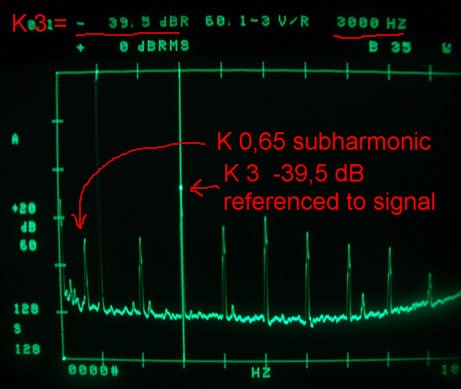
Oh dear... I absolutely did *not* want this thread to turn into a measurement "love-in", as that completely misses the point of the project. A little perspective is in order, I think...
(TDA1540-based CD304)
No, it isn't. Really. Virtually all the distortion is harmonic, and what isn't is very low down. (That glitch at ~7200Hz could well be from the soundcard, IMO - which BTW should have ideally been named.)
Here's something for you to try... notch out the 1kHz fundamental from the -60dB sine after the part on test, and *listen* to the residue at a normal listening level for dynamically compressed material (so 0dBFS corresponds to, for example, something like 80-85 SPL).
Hear anything? No, thought not...
Unless you listen to entirely uncompressed recordings recorded in an anechoic chamber where 0dBFS needs to be equal to something like 120 SPL, or wish to use a large amount of digital attenuation, I would not be overly concerned.
SAA7310 is the disc decoder, AFAIK... SAA7220 is quoted as the partnering filter.
The 12-bit coefficients inevitably make for a rough passband compared to modern standards, but even so, the ripple shown is only borderline in audibility (how flat are your speakers and ears?). Some of it is probably also down to the steep analogue lowpass filtering these early players tend to incorporate - the elliptic/cauer types give more stopband for increased passband ripple... and can also cause quite a bit of non-linear phase shift.
A lot of speculation is offered in Bernhard's post with regard to correlation between between harmonics and sound, but I don't see much to back it up. The comparison between 1540 and 1541 looks shaky at best unless the chips are used in exactly the same situation. And this is a very primitve test signal.
Still, I think it's worth showing that the Discrete is no dog in this regard... at least when the audio is processed in a suitable way. I could just as easily process it another way and get a much worse result.
No more measurements from other devices for now, please, unless you're able to display hard data (ideally a capture in the digital domain, no A/D involved) about the quality of the digital filters in potential donor players.
I would rather people build...
- Tom.
(TDA1540-based CD304)
The low level distortion of the DACs is prety awful...
No, it isn't. Really. Virtually all the distortion is harmonic, and what isn't is very low down. (That glitch at ~7200Hz could well be from the soundcard, IMO - which BTW should have ideally been named.)
Here's something for you to try... notch out the 1kHz fundamental from the -60dB sine after the part on test, and *listen* to the residue at a normal listening level for dynamically compressed material (so 0dBFS corresponds to, for example, something like 80-85 SPL).
Hear anything? No, thought not...
Unless you listen to entirely uncompressed recordings recorded in an anechoic chamber where 0dBFS needs to be equal to something like 120 SPL, or wish to use a large amount of digital attenuation, I would not be overly concerned.
All players i tested show a very weird frequency response plot, and i think this is due to the digital filter SAA7310.
SAA7310 is the disc decoder, AFAIK... SAA7220 is quoted as the partnering filter.
The 12-bit coefficients inevitably make for a rough passband compared to modern standards, but even so, the ripple shown is only borderline in audibility (how flat are your speakers and ears?). Some of it is probably also down to the steep analogue lowpass filtering these early players tend to incorporate - the elliptic/cauer types give more stopband for increased passband ripple... and can also cause quite a bit of non-linear phase shift.
A lot of speculation is offered in Bernhard's post with regard to correlation between between harmonics and sound, but I don't see much to back it up. The comparison between 1540 and 1541 looks shaky at best unless the chips are used in exactly the same situation. And this is a very primitve test signal.
Still, I think it's worth showing that the Discrete is no dog in this regard... at least when the audio is processed in a suitable way. I could just as easily process it another way and get a much worse result.
No more measurements from other devices for now, please, unless you're able to display hard data (ideally a capture in the digital domain, no A/D involved) about the quality of the digital filters in potential donor players.
I would rather people build...

- Tom.
Attachments
Originally posted by tbrowne I would rather people build...
So would I, but most of us need a complite project like this discrete 16-bit DAC (CS8412 input receiver, mode 5 output format) for start with...
http://www.ueno.no-ip.org/~tube-audio/DAC/circuit/Dac3.gif
or this 24-bit discrete DAC, preferably
http://www.ueno.no-ip.org/~tube-audio/DAC/avr8535_dac/
Best, a
Konnichiwa,
Well, where lies Tome Browne's body or what was that old song?
Serious, why should we build anything if we can make one dimensional measurements that show poor or no correlation with subjective sonics and p[ontificate endlessly about them, what they mean and how the results sound, where is the fun in that?
A mentor of mine once told me what his Architecture professor told him on the subject of building: "Talk about it, write about it, consult about it, design it, but under circumstances should you build something!"....
Sayonara
tbrowne said:No more measurements from other devices for now, please, unless you're able to display hard data (ideally a capture in the digital domain, no A/D involved) about the quality of the digital filters in potential donor players.
I would rather people build...
Well, where lies Tome Browne's body or what was that old song?
Serious, why should we build anything if we can make one dimensional measurements that show poor or no correlation with subjective sonics and p[ontificate endlessly about them, what they mean and how the results sound, where is the fun in that?
A mentor of mine once told me what his Architecture professor told him on the subject of building: "Talk about it, write about it, consult about it, design it, but under circumstances should you build something!"....
Sayonara
Kuei Yang Wang said:Konnichiwa,
Well, where lies Tome Browne's body or what was that old song?
But his dac goes marching on?
Hi tom
On your post #41 you stated some preoccupation about the performance of the 14 bit players. I thought that frequency response was something to care about... my intention was not to "hijack" your thread.
I completely agree with you. With a single tone, but if this CD player has this type of performance with a single tone, imagine what it does with music... The distortion becomes audible, at least, in my subjective experience. (I have a player that shows no harmonics in the same test)
My fault, I meant to say SAA7030. The SAA7220 shows no ripple problem on the frequency response.
The Philips 14bit machines (schematic is available on request if ask my friend electropt), don’t use steep analog filters, because they use oversampling.
The filter is quite simple, a 6dB lowpass on the i/v converter and a sallen key 12dB lowpass.
I question the digital filter because TDA1541 based machines use the same configuration in the analog filter, and like I said, they don’t show that kind of response.
Unfortunately I don’t have that kind of equipment, but you can get good information from some simple tests...
I'm building some other vary interesting stuff in the analog department. Some discrete RIAA'S.😎
Sorry for the information not being that useful...
Cheers
Ricardo
Ps: I sold my Phillips CD303 today and I won’t miss it one bit😀
Oh dear... I absolutely did *not* want this thread to turn into a measurement "love-in", as that completely misses the point of the project. A little perspective is in order; I think...
On your post #41 you stated some preoccupation about the performance of the 14 bit players. I thought that frequency response was something to care about... my intention was not to "hijack" your thread.
Here's something for you to try... notch out the 1kHz fundamental from the -60dB sine after the part on test, and *listen* to the residue at a normal listening level for dynamically compressed material (so 0dBFS corresponds to, for example, something like 80-85 SPL).
I completely agree with you. With a single tone, but if this CD player has this type of performance with a single tone, imagine what it does with music... The distortion becomes audible, at least, in my subjective experience. (I have a player that shows no harmonics in the same test)
SAA7310 is the disc decoder, AFAIK... SAA7220 is quoted as the partnering filter
My fault, I meant to say SAA7030. The SAA7220 shows no ripple problem on the frequency response.
The 12-bit coefficients inevitably make for a rough passband compared to modern standards, but even so, the ripple shown is only borderline in audibility (how flat are your speakers and ears?). Some of it is probably also down to the steep analogue lowpass filtering these early players tend to incorporate - the elliptic/cauer types give more stopband for increased passband ripple... and can also cause quite a bit of non-linear phase shift.
The Philips 14bit machines (schematic is available on request if ask my friend electropt), don’t use steep analog filters, because they use oversampling.
The filter is quite simple, a 6dB lowpass on the i/v converter and a sallen key 12dB lowpass.
I question the digital filter because TDA1541 based machines use the same configuration in the analog filter, and like I said, they don’t show that kind of response.
No more measurements from other devices for now, please, unless you're able to display hard data (ideally a capture in the digital domain, no A/D involved) about the quality of the digital filters in potential donor players.
Unfortunately I don’t have that kind of equipment, but you can get good information from some simple tests...
I would rather people build...
I'm building some other vary interesting stuff in the analog department. Some discrete RIAA'S.😎
Sorry for the information not being that useful...
Cheers
Ricardo
Ps: I sold my Phillips CD303 today and I won’t miss it one bit😀
So would I, but most of us need a complite project like this discrete 16-bit DAC (CS8412 input receiver, mode 5 output format) for start with...
Ahem... if you've got a schematic from Japan right there, you know how to set up the receiver chip, and interested in the concept, what precisely is stopping you? This is DIY, not Plug'N'Play... get a bit of veroboard and just do it. The hard bit is the ladder... can always change the logic circuitry and front end at a later date.
I might not have had good experiences with NOS myself with two different DACs, but there's nothing to stop other people from trying it. Don't worry if the layout is not great... Rev.1 through 3 of mine were a nest of wires, and I still enjoyed the sound. Just make a good effort matching the resistors.
I have already explained why I haven't developed an S/PDIF interface. There is nothing to stop one of the many people experienced with digital audio here to develop something like that and publish it, if they so wish. A basic circuit is easy, but wouldn't be good enough, I feel.
To really get the most out of the DAC, you need DSP power for a custom filter which can apply the most effective dither/shaping. But even so, I think something good could be attained with a regular part.
Any schematic for an existing design which uses dual-mono DACs with a filter chip can be adapted without too much trouble, in all probability. The one I've looked at most recently was the one Guido Tent worked on (does the NPC chip have a slow roll-off filter option?)... or how about the Assemblage series? I think some of those schematics are floating around...
The PMD100 is probably one of the best off-the-shelf filter chips to use with the Discrete, but I would not expect anyone to butcher the likes of a Rotel RCD-971 or 991 to put Discretes in. Unless they really didn't like how it sounded. Speaking of which, IIRC, the 991 lets you change dither modes out-of-the-box... a nice touch, as it could have a significant impact on Discrete performance, judging from what I'm seeing here.
Well, where lies Tome Browne's body or what was that old song?
In front of a machine, trying to write a coherent forum post after over an hour... 🙂
Serious, why should we build anything if we can make one dimensional measurements that show poor or no correlation with subjective sonics and p[ontificate endlessly about them, what they mean and how the results sound, where is the fun in that?
It holds some entertainment value at an academic level, but it really takes something special to show just how much we absorb from other people without questioning.
The Discrete was a bit of a revelation, as it completely shattered some previous "rules" for me, like...
- More resolution is always better
- High order harmonics are really bad, even if low level
It's hard to ignore what you hear, but I see no harm in remaining skeptical.
A mentor of mine once told me what his Architecture professor told him on the subject of building: "Talk about it, write about it, consult about it, design it, but under circumstances should you build something!"....
Immediately I felt the word "no" was missing betwen "under" and "circumstances"... but let's keep the message positive... 🙂
KYW is the only taker for a pair of boards and bits so far. That leaves one set.
- Tom.
Hi Rick,
Okay... I just didn't like the direction it was going in. Yes, frequency response is something to care about to an extent, but it's pretty hard to get it badly wrong with a DAC... buggy SRCs are better at that... 🙂
Looking at the datasheets, it seems they moved from 24 taps to 30 taps.
Ah... I should have looked at the SA7220 sheet for a more recent application note... at the end, it shows a 3rd order Bessel after the TDA1541...
Getting a bit OT again, but is your Panasonic DVD player your main unit now? I've a DVD-S75 downstairs, and find it very mediocre on CDs.
- Tom.
On your post #41 you stated some preoccupation about the performance of the 14 bit players. I thought that frequency response was something to care about... my intention was not to "hijack" your thread.
Okay... I just didn't like the direction it was going in. Yes, frequency response is something to care about to an extent, but it's pretty hard to get it badly wrong with a DAC... buggy SRCs are better at that... 🙂
My fault, I meant to say SAA7030. The SAA7220 shows no ripple problem on the frequency response.
Looking at the datasheets, it seems they moved from 24 taps to 30 taps.
The filter is quite simple, a 6dB lowpass on the i/v converter and a sallen key 12dB lowpass.
Ah... I should have looked at the SA7220 sheet for a more recent application note... at the end, it shows a 3rd order Bessel after the TDA1541...
Ps: I sold my Phillips CD303 today and I won’t miss it one bit 😀
Getting a bit OT again, but is your Panasonic DVD player your main unit now? I've a DVD-S75 downstairs, and find it very mediocre on CDs.
- Tom.
Sorry to wander o/t, but......
The SAA7220 has a zero in the response, at 44 kHz, to cancel out one of the poles in the 3rd order LPF. The logic of that evades me.........
BTW, it is John Brown's body. Based (I believe) on the Harper's Ferry Raid, prior to the American Civil War.
Or as we call it........."the War of Yankee Agression."
Over to you, Tom.......
Jocko
The SAA7220 has a zero in the response, at 44 kHz, to cancel out one of the poles in the 3rd order LPF. The logic of that evades me.........
BTW, it is John Brown's body. Based (I believe) on the Harper's Ferry Raid, prior to the American Civil War.
Or as we call it........."the War of Yankee Agression."
Over to you, Tom.......
Jocko
tbrowne said:
Ahem... if you've got a schematic from Japan right there, you know how to set up the receiver chip, and interested in the concept, what precisely is stopping you?
This...😀 http://www.ueno.no-ip.org/~tube-audio/DAC/circuit/dac_out.gif
Hi Tom
My panasonic is a DVD-XV10(it uses a PCM1742K dac), and to my view, in my system, it suonds quite nice, clearly more neutral than 14 bit players. Right now this dvd makes company to the Panasonic full digital amplifier at my brother house...
My main player is a Pioneer Elite with R2R Burr Brown dacs.
Cheers
Getting a bit OT again, but is your Panasonic DVD player your main unit now? I've a DVD-S75 downstairs, and find it very mediocre on CDs.
My panasonic is a DVD-XV10(it uses a PCM1742K dac), and to my view, in my system, it suonds quite nice, clearly more neutral than 14 bit players. Right now this dvd makes company to the Panasonic full digital amplifier at my brother house...
My main player is a Pioneer Elite with R2R Burr Brown dacs.
Cheers
The SAA7220 has a zero in the response, at 44 kHz, to cancel out one of the poles in the 3rd order LPF. The logic of that evades me.........
I was aware of that characteristic of the SAA7220. Read it on an Analog devices application note.
Still can’t comprehend why there no hint of this behaviour on the Philips datasheet

Regards
What does that represent? The babelfish translation of "The ripple mark was such feeling" does not make a great deal of sense.
While I like that the author has gone and built something, I would not place a great deal of faith in someone who uses 5% carbon resistors to build a 16-bit ladder (surely just about the worst choice you could make)... and then says something along the lines of "hmm... I guess matching is important"... !!
This is something that should have been established before they started to build, I think. It only takes a calculator or a bit of paper for a rough estimate.
Try to measure the resistors to 0.01% or better. Even at the upper edge of the measuring range, with normal measuring the best you are likely to get from a 4 digit DMM is 0.02%. But you could use a precision voltage divider or bridge circuit to improve on that.
There is also no sign that they compensated for switch Z - doing so could result in a big drop of harmonics... IF the ladder was any good - their design probably has them at a very audible level.
In the version with 74AC logic output, I'd expect significantly lower Z than HC, but still should not be ignored. Do not even think about a 1k/2k ladder directly from logic without paralleling chips... the switch Z will dominate too much, and you'll be lucky to get 8 bits. PSU impedance also becomes a bigger issue.
10k/20k is rather more doable. If you feel confident about building a high impedance buffer that will be compatible (as in not wreck the sound), why not 50k/100k? Just be aware that the noise and distortion from the resistors is a bit higher.
Regarding the 74AC logic in the Japanese schematic, I don't think it's a good choice into the ladder... it is not designed for low noise. HC is a better choice, but the Z is a bit high - AHC or VHC seem to offer similar noise but lower Z.
The SAA7220 has a zero in the response, at 44 kHz, to cancel out one of the poles in the 3rd order LPF. The logic of that evades me.........
What I really have trouble getting my head around is their use of even-tap filters... this is one of the reasons I'm curious to see what the actual coefficients look like...
- Tom.
Re: Sorry to wander o/t, but......
Konnichiwa,
I am quite familiar with the Harper Ferry raid, John Brown and all, thanks to the good offices of the Discovery Channel (Cue - Bloudhound Gang - "Bad Touch").
My line was an attempt on humor, intended to be somewhat more killing than the Peanut joke.
Sayonara
Konnichiwa,
Jocko Homo said:BTW, it is John Brown's body. Based (I believe) on the Harper's Ferry Raid, prior to the American Civil War.
I am quite familiar with the Harper Ferry raid, John Brown and all, thanks to the good offices of the Discovery Channel (Cue - Bloudhound Gang - "Bad Touch").
My line was an attempt on humor, intended to be somewhat more killing than the Peanut joke.
Sayonara
- Status
- Not open for further replies.
- Home
- Source & Line
- Digital Line Level
- Discrete DAC
